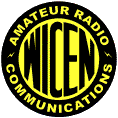
 |
WICEN Tasmania (South) heads North East to Horses, Cheese, Sushi and a Beer Swilling Pig
Report on Pyengana Equine Endurance Ride - Portland Endurance Riders.
The ride was on 20th June in the delightful country between Pyengana and Goshen, west of St Helens. The weather held up well for setting up and the ride itself. Overnight conditions on Friday and Saturday included thick fog and very heavy downpours.
Four WICEN vehicles with two trailers left from the rendezvous in Snug at 09:00 on Friday morning and headed up the Channel, Midlands, Esk and Tasman highways, with a brief stop in Campbell Town for coffee, nibbles and requisite discharges. Also, a brief encounter with Rex VK7MO en route to Mt Barrow. In St Helens, Chris FCDW with XYL Liz and NXX with XYL Bev checked into their motel before continuing on. VK7s ARN Roger, FMRS Michael, and JGD Garry headed on to Pyengana to begin the set up. VK7s FAME Steve and FRAE Rhonda had to work on the Friday so joined us late in the evening after a long, dark and foggy drive.
The endurance ride was organised by Portland Endurance Riders, a small local club. Its six committee members were surprised but delighted with the record number of entries for the event, which included 40 and 80 kilometre rides. Our involvement came about by a chance encounter in St Helens by the club Secretary Tara Nicklason and an occasional WICEN member ‘Tiny’ Damien ex VK7LDA. The club had experienced difficulties in maintaining communications between base and checkpoints and were looking for surety of communications. Damien suggested WICEN and exchanges of emails brought us to Pyengana.
Radio Mobile software indicated we could do the job with a repeater on an easily accessible hill top approximately central to the rides. Peter VK7TPE and Chris VK7FCDW were working on Targa Tasmania in April so, by arrangement with Ron VK7ZRO, Peter and Chris were deployed so as to be close to Pyengana. They met up with Tara and did a quick survey to confirm the Radio Mobile results. As it turned out, the difficult checkpoint near Goshen was later relocated enabling simplex comms. During the Targa site meeting, Chris had mentioned APRS tracking capability which was quickly accepted by Tara. This would definitely need a temporary digipeater so the planned repeater site became an additional checkpoint and digi site.
On arrival at the ride base at the Pyengana recreation ground we found truly luxurious conditions awaited. Our base was in the hall, with running water, ablutions and, later, a Lions club run cafeteria. Our friend Ossie Owens, President of our usual ‘client’ ride club, Southern Tasmanian Endurance Riders, was there and made it clear that we were being spoiled and not to expect such housing and other conditions on STER rides!
Three base units were established; APRS, Checkpoints and ride organisers. APRS and checkpoints shared a dual band radio and antenna on a 12m mast.
A third network was set up, on a WICEN licensed commercial frequency, for ride organisers and utilising a mag base whip on the community centre roof.
Garry VK7JGD, and Michael VK7FRMS went off up the hill to check simplex comms and to establish the APRS digipeater which was left on site overnight to monitor our movements and to look out for the late arrivals coming up from Hobart. The site had a good path to VK7RAA on Mt Barrow. Steve and Rhonda’s track was covered all the way from Hobart via RAD, REC, RAA and our temporary digi. An unusual occurrence as ‘trackees’ normally drop of the edge of the APRS world when descending to the coast from St Marys.
The final preparatory job was to be guided to the checkpoint locations by club committee man Ged. Chris and Michael headed off into the near dark for the guided tour.
Satisfied all was in order at Base, Stu, Bev, and Liz went to the nearby Pub in the Paddock, famous for its beer drinking pig, for a counter meal. Chris, still 'on the hill', was harassed by radio to be quick and join the waiting gannets so they could eat. Duty done, he headed off to join them for the meal before all returning to St Helens for the night. Garry, Michael and Roger prepared their own meals at the Base and awaited Steve and Rhonda’s arrival before all retiring for the night in the backs of respective vehicles and, in Roger’s case, a tent.
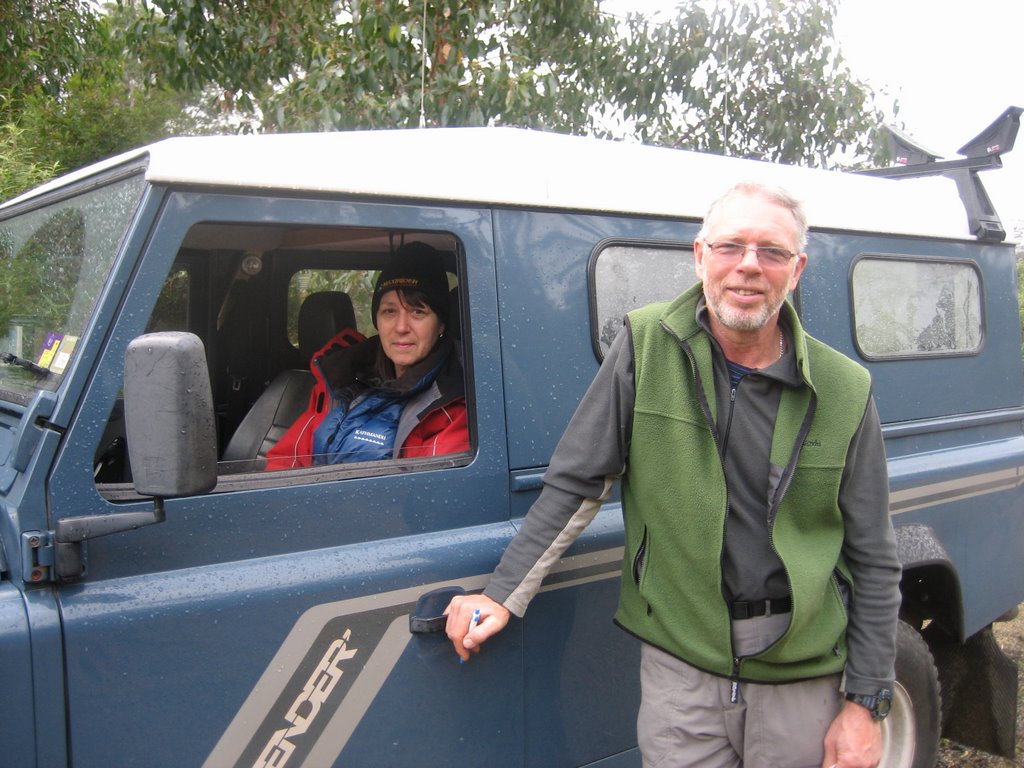
When the beacons were being heard directly, Garry returned to Base, the antenna switched to a mag base dual band and the 12 metre mast lowered, packed up and hitched to Garry’s vehicle for his return to Snug.
When the tailenders arrived back at Base, Stu, Chris and Roger packed up the gear and prepared for the feast laid on by the Club for the riders, strappers, other supporters and the workers, including us. Bev and Liz were ferried from St Helens to join us for the lamb spit roast, potatoes and a selection from the 12 metre long table of side dishes. This followed by the same table now filled with pavlovas and other goodies. Prizes were presented before all returned to various accommodations for a very wet and noisy night (for clarification - rainfall caused!)
The residual WICEN group returned, or more correctly grazed its way, to the south via the East Coast with eggs and bacon in St Helens, and sushi and Devonshire Tea at Kabuki by the Sea. In all, a very enjoyable weekend and, most importantly, a very satisfied ‘client’. Our adoption of the ARRL’s slogan “When All Else Fails – Amateur Radio Works” was justified!
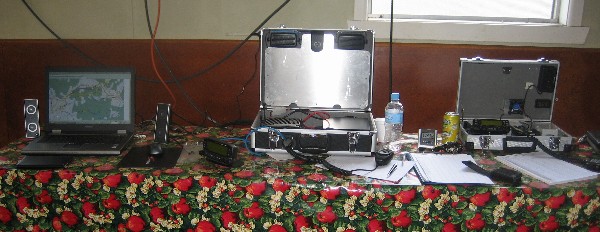
The equipment used was:
Base and APRS radio – Kenwood D710A, Diamond X-50 on 12m telescopic trailer mounted mast.
Base APRS monitoring The D710A coupled to a notebook PC running AGW Packet Engine Pro and AGW Tracker.
Checkpoints – Various 2m rigs
APRS portable - Puxing 777, TinyTrak III Plus, DeLuo SiRF III GPS in the outer of a hydration back pack.
APRS digi – PRM8025, PacCom Tiny 2 TNC, Diamond X-30 on tripod mount mast
Supplied for ride organiser use – VHF high band PRMs mounted in cases with mag base whips (non Amateur licensed by WICEN)
Photos by Chris VK7FCDW
What we did on top of what the organisers wanted and when we did they were delighted.
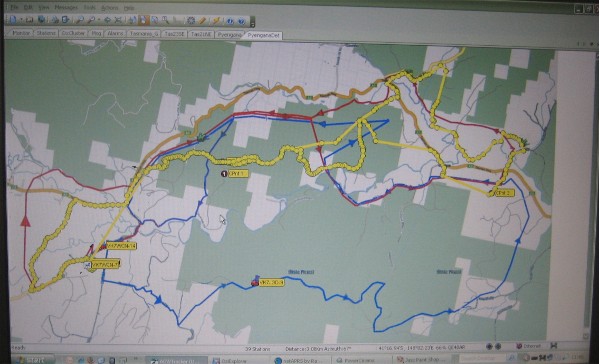
An advantage of a rider carrying a tracker was that we would end up with a map of the real course. Another advantage was that our ‘trackee’ was a young rider and this was her first 80Km ride. Mum was concerned she might become lost and therefore happy that we would know where her daughter was throughout.
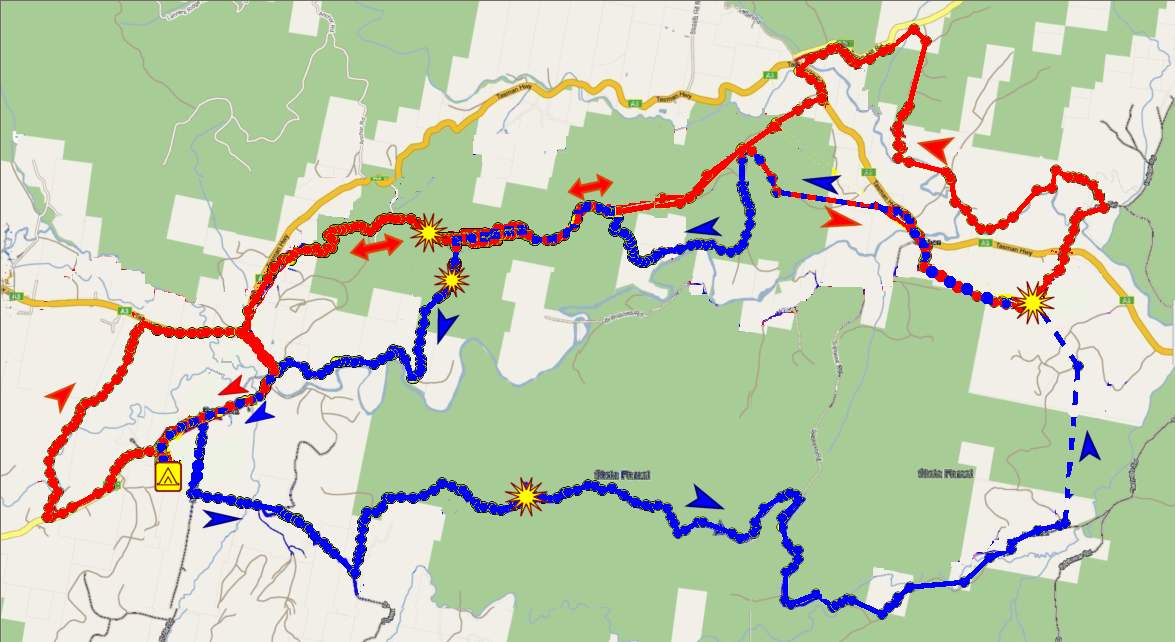 The exercise was successful in that 95% of
the course was accurately mapped. The remaining 5% was sparsely covered because
a) the tracker battery ran out a couple of Kms from home on the first leg, and
b) because parts of the far end of the course were out of ‘site’ of the
digipeater. These can be seen by the sparsity of beacon ‘blobs’ and the dashed lines between them.
The exercise was successful in that 95% of
the course was accurately mapped. The remaining 5% was sparsely covered because
a) the tracker battery ran out a couple of Kms from home on the first leg, and
b) because parts of the far end of the course were out of ‘site’ of the
digipeater. These can be seen by the sparsity of beacon ‘blobs’ and the dashed lines between them.
Many of the riders' supporters were frequent visitors to Base to see how things were progressing. The Base operators' voices were stretched more by responding to queries and promoting Amateur Radio than they were by the primary business of taking and responding to reports from the Checkpoints!